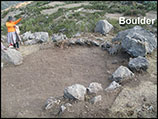Published online by Cambridge University Press: 08 July 2019

The Inca mitmaq policy ambitiously resettled up to one-third of its subject population. Despite the importance of this mass relocation, we know little of the mitmaqkuna, the people resettled under the policy. Through a spatial analysis of Yanawilka, an agricultural mitmaq settlement near the Inca provincial capital of Vilcashuamán, this article explores how Inca imperial control differentially affected various aspects of the mitmaqkuna's social landscapes. The use of space syntax analysis to assess the centrality of the Inca imperial presence within such settlements may be of value for assessing other imperial contexts around the world.